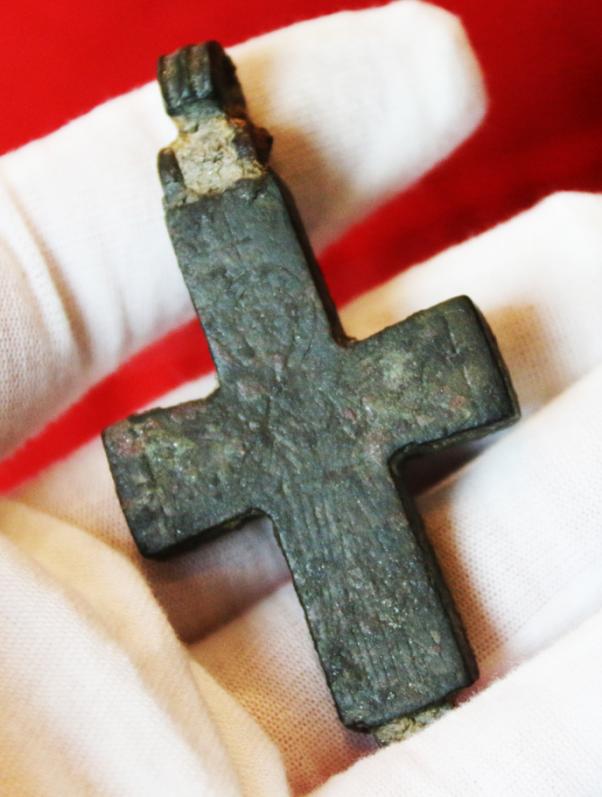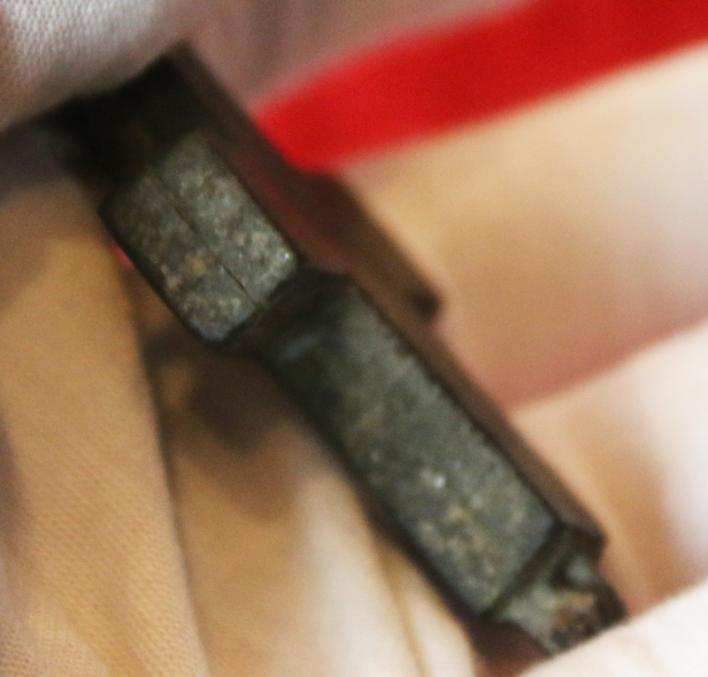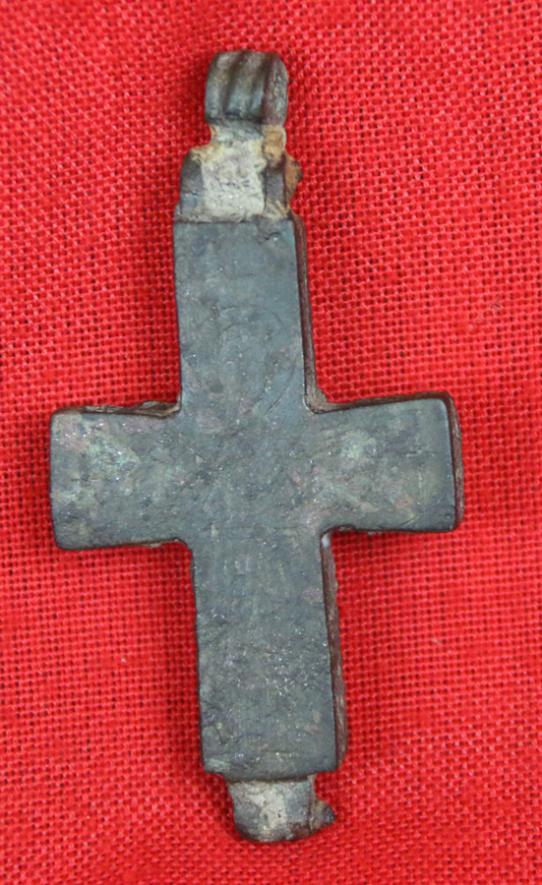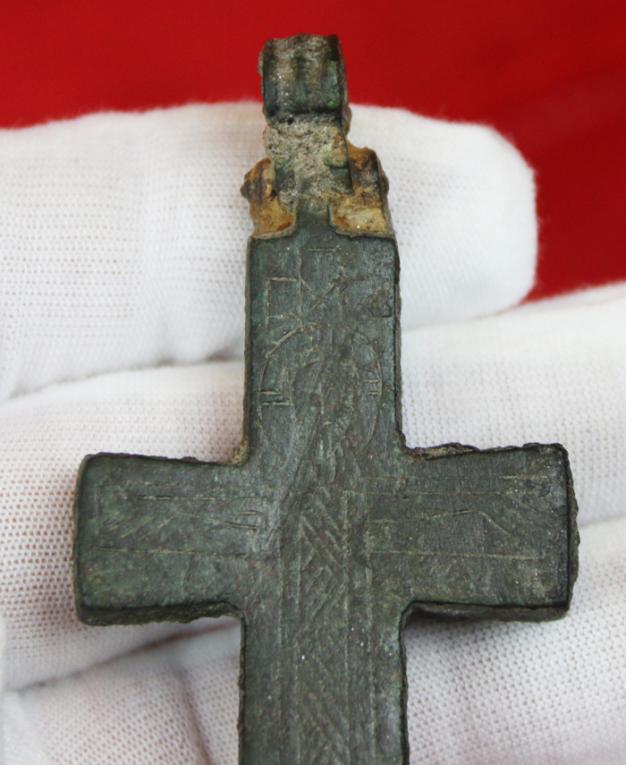10th to 11th Century Earliest Crusader Knights Period Bronze Encolpion Reliquary Cross. Large Size Cross To Adorn The Chest of A Crusader Pilgrim, Designed To Hold A Relic Of The True Cross of Christ’s Crucifiction
On the face of this work the engraved crucified Christ appears, he wears the colobium, an iconographic type established in the Early Christian centuries. On the reverse, the Virgin Mary (Mother of God) stands in an orans prayer pose. The hollow portion formed inside the box was intended for the sacred relic that the faithful would have worn around the neck. Remarkably it still remains sealed so the relic within may likely still be enclosed within.
Part of an amazing collection of Crusades period Crucifixes and reliquary crosses for the early Anglo Norman Crusader knights and Jerusalem pilgrims. As used in the early Crusades Period by Knights, such as the Knights of Malta Knights Hospitaller, the Knights of Jerusalem the Knights Templar, the Knights of St John.The new Norman rulers were culturally and ethnically distinct from the old French aristocracy, most of whom traced their lineage to the Franks of the Carolingian dynasty from the days of Charlemagne in the 9th century. Most Norman knights remained poor and land-hungry, and by the time of the expedition and invasion of England in 1066, Normandy had been exporting fighting horsemen for more than a generation. Many Normans of Italy, France and England eventually served as avid Crusaders soldiers under the Italo-Norman prince Bohemund I of Antioch and the Anglo-Norman king Richard the Lion-Heart, one of the more famous and illustrious Kings of England.
An encolpion "on the chest" is a medallion with an icon in the centre worn around the neck upon the chest. This stunning and large neck worn example is bronze three part with its hinged top. 10th to 12th century. The hollow portion formed inside the cross was intended for the sacred relic that the faithful would have worn around the neck. The custom of carrying a relic was largely widespread, and many early bronze examples were later worn by the Crusader knights on their crusades to liberate the Holy Land. Relics of the True Cross became very popular from the 9th century, and were carried in cross-shaped reliquaries like this, often decorated with enamels, niellos, and precious stones. The True Cross is the name for physical remnants from the cross upon which Jesus Christ was crucified. Many Catholic and Orthodox churches possess fragmentary remains that are by tradition believed to those of the True Cross. Saint John Chrysostom relates that fragments of the True Cross were kept in reliquaries "which men reverently wear upon their persons". A fragment of the True Cross was received by King Alfred from Pope Marinus I (Anglo-Saxon Chronicle, year 883). An inscription of 359, found at Tixter, in the neighbourhood of Sétif in Mauretania, was said to mention, in an enumeration of relics, a fragment of the True Cross, according to an entry in Roman Miscellanies, X, 441.
Fragments of the Cross were broken up, and the pieces were widely distributed; in 348, in one of his Catecheses, Cyril of Jerusalem remarked that the "whole earth is full of the relics of the Cross of Christ," and in another, "The holy wood of the Cross bears witness, seen among us to this day, and from this place now almost filling the whole world, by means of those who in faith take portions from it." Egeria's account testifies to how highly these relics of the crucifixion were prized. Saint John Chrysostom relates that fragments of the True Cross were kept in golden reliquaries, "which men reverently wear upon their persons." Even two Latin inscriptions around 350 from today's Algeria testify to the keeping and admiration of small particles of the cross. Around the year 455, Juvenal Patriarch of Jerusalem sent to Pope Leo I a fragment of the "precious wood", according to the Letters of Pope Leo. A portion of the cross was taken to Rome in the seventh century by Pope Sergius I, who was of Byzantine origin. "In the small part is power of the whole cross", says an inscription in the Felix Basilica of Nola, built by bishop Paulinus at the beginning of 5th century. The cross particle was inserted in the altar.
The Old English poem Dream of the Rood mentions the finding of the cross and the beginning of the tradition of the veneration of its relics. The Anglo-Saxon Chronicle also talks of King Alfred receiving a fragment of the cross from Pope Marinus (see: Annal Alfred the Great, year 883). Although it is possible, the poem need not be referring to this specific relic or have this incident as the reason for its composition. However, there is a later source that speaks of a bequest made to the 'Holy Cross' at Shaftesbury Abbey in Dorset; Shaftesbury abbey was founded by King Alfred, supported with a large portion of state funds and given to the charge of his own daughter when he was alive – it is conceivable that if Alfred really received this relic, that he may have given it to the care of the nuns at Shaftesbury
Most of the very small relics of the True Cross in Europe came from Constantinople. The city was captured and sacked by the Fourth Crusade in 1204: "After the conquest of the city Constantinople inestimable wealth was found: incomparably precious jewels and also a part of the cross of the Lord, which Helena transferred from Jerusalem and which was decorated with gold and precious jewels. There it attained the highest admiration. It was carved up by the present bishops and was divided with other very precious relics among the knights; later, after their return to the homeland, it was donated to churches and monasteries.To the category of engolpia belong also the ampullae, or vials or vessels of lead, clay or other materials in which were preserved such esteemed relics as oil from the lamps that burned before the Holy Sepulchre, and the golden keys with filings from St. Peter's chains, one of which was sent by St. Gregory the Great to the Frankish King Childebert.
Encolpion, a different anglicization of the same word, covers the early medieval tradition in both Eastern and Western Christianity. Superb condition, top swivel ring mount immobile, still sealed, so it may still contain part of the 'real cross'.
Surface in very good condition, with typical natural aged patina with encrustations. 7.5 cms x 3.9cms
Code: 23287
1495.00 GBP






